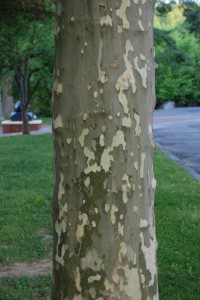American sycamore, aka planetree, (Platanus occidentalis) is a native tree planted over a large area of the United States (USDA hardiness zones 4-9). Its enormous size, often 70-90 feet in height, limits it to planting mostly on large landscapes such as parks, golf courses, and industrial parks. Northern U.S. cities have planted it extensively along major thoroughfares, wide avenues and boulevards. Sycamore is commonly utilized in reforestation work because it grows in a great variety of soils, wet or dry, and copes with most environmental situations including urban pollution.
Smooth white patchwork bark is its most identifiable winter feature. Chunks of bark, sometimes quite large, flake off to reveal a chalky white inner bark. Caveat: sycamore (planetree) is a messy tree. Chunks of fallen bark, gumball fruits, and numerous twigs, add up to a potential maintenance nightmare. Seedling trees are susceptible to spring leaf anthracnose, aphids, and lacebugs. Damaged leaves will litter lawn areas in mid-spring; the arrival of warm dry summer weather usually checks the disease and insect onslaught.
Sycamore grows very rapidly in either full or part sun (6 hours preferred). The roots of older trees tend raise up sidewalks and clog water, sewer and septic lines. Despite numerous pest and disease issues, American sycamore grows very aggressively,gaining in size and stature. Do not crowd trees close together to allow good air movement and less disease outbreaks.
London Planetree (P. x acerifolia) is a cross between Oriental planetree (P. orientalis) and American sycamore. Its disease resistance has made it the better choice and one of the most popular large trees in urban Mid-Atlantic and Midwest states (USDA hardiness zones 4-9). Good disease resistant cultivars of hybrid planetrees include ‘Columbia’, ‘Liberty’, ‘Yarwood’, and Exclamation™.


 Posted in
Posted in 
